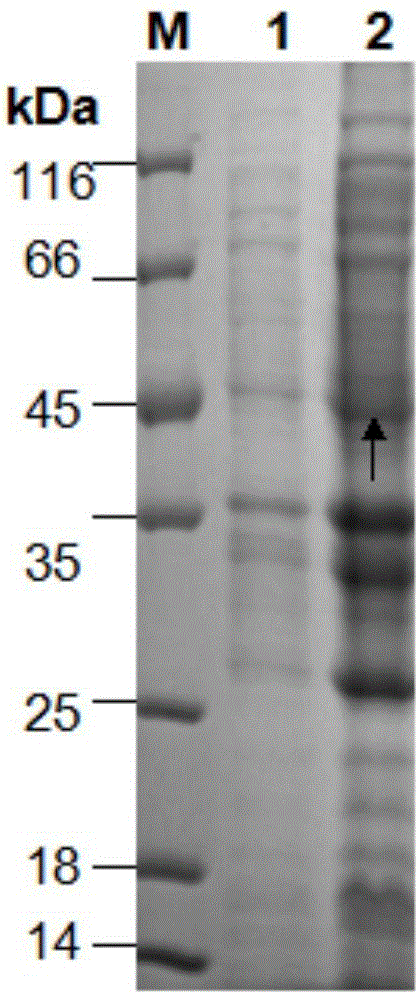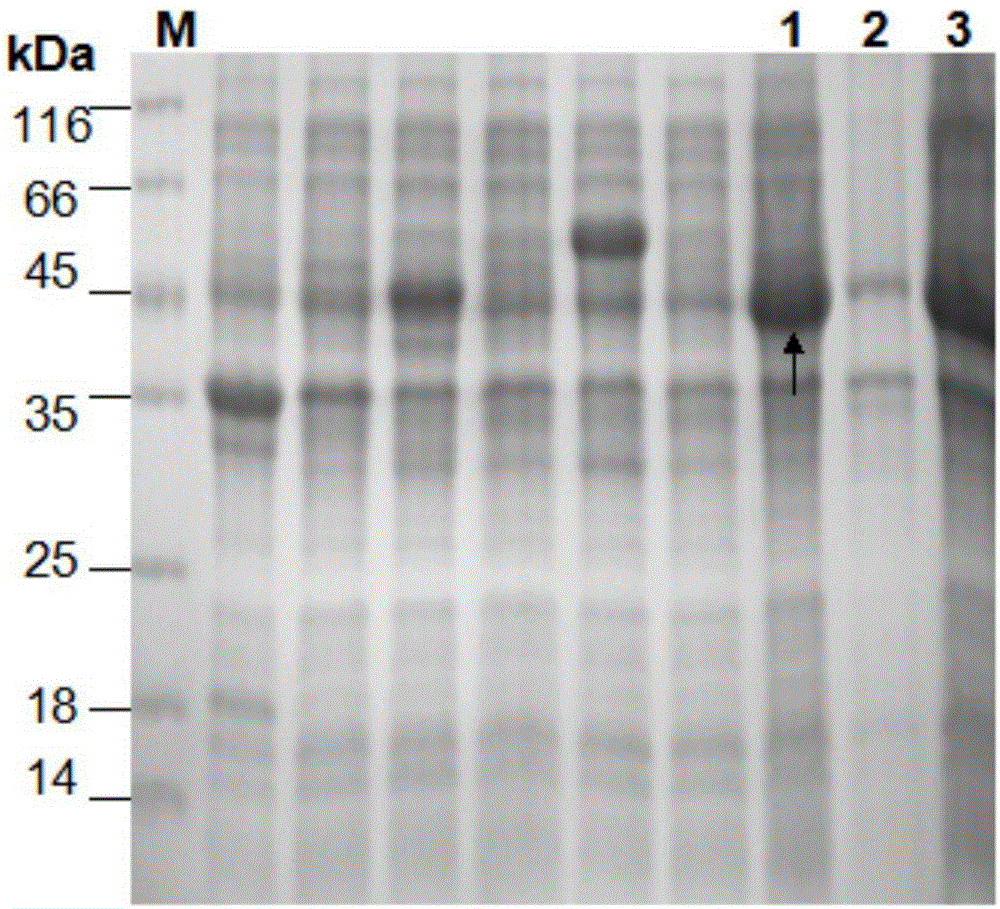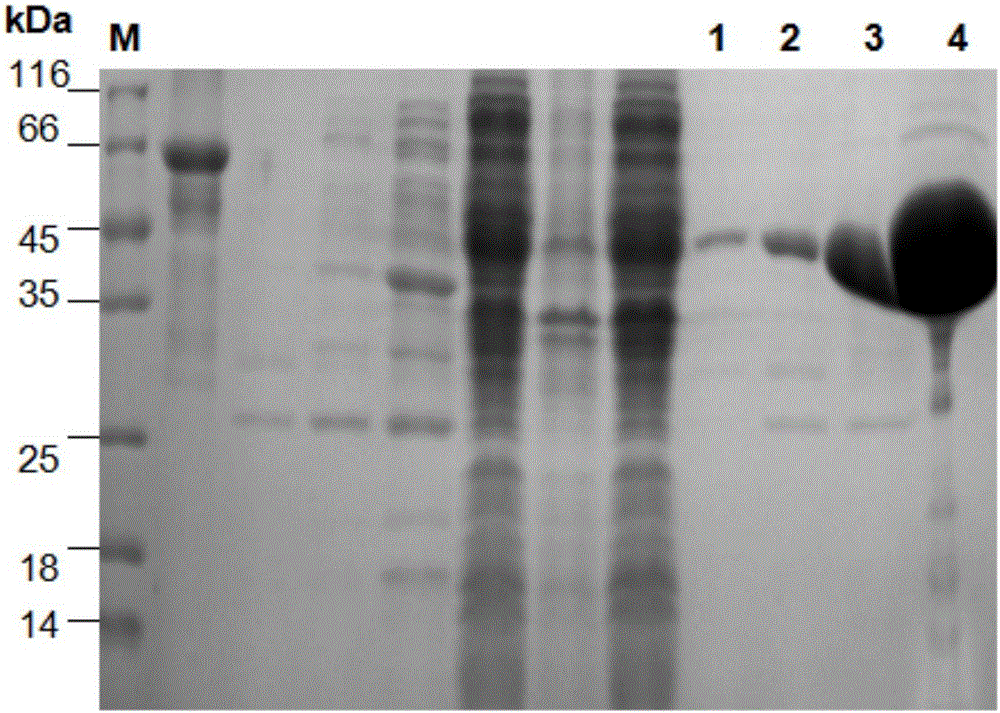Transgenic protein g10-epsps quantitative detection method and used kit
A technology of g10-epsps and 1.g10-epsps, applied in the field of acquisition and quantitative detection of transgenic protein EPSPS, can solve the problems of complex sample processing, high requirements for venues, instruments, and technical personnel, and no detection methods, etc., to achieve The effect of accurate quantitative detection method, low cost and short operation time
- Summary
- Abstract
- Description
- Claims
- Application Information
AI Technical Summary
Problems solved by technology
Method used
Image
Examples
Embodiment 1
[0060] Embodiment 1, expression and purification of EPSPS protein
[0061] (1) Small-scale expression of protein
[0062] 1. Carrier Construction
[0063] According to the protein sequence (g10-epsps), the gene sequence was synthesized and constructed into the vector pET30a to obtain the pET30a-EPSPS positive plasmid.
[0064] 2. Strain activation: The g10-epsps-E positive plasmid was constructed using the commercial ET expression vector backbone sold by EMD Biosciences, transformed into BL21(DE3), and coated with LB solid medium (Kana concentration 50 μg / mL). On the next day, single-clonal colonies were picked and inserted into 5 mL of LB liquid medium (Kana concentration 50 μg / mL), and cultured at 37°C for 12h-14h.
[0065] 3. Small test expression: the next day, the bacteria were inserted into 5mL LB liquid medium (Kana concentration 50μg / mL) at 1:50 (v:v), cultivated at 37°C until OD=0.4-0.6, and absorbed 1mL of the bacteria solution After centrifugation, it was used as...
Embodiment 2
[0076] Embodiment 2, antibody preparation
[0077] (1) Monoclonal antibody preparation:
[0078] 1. Immunogen preparation: Mix and emulsify the expressed and purified protein with an equal volume of Freund's adjuvant and YOULONG adjuvant into a water-in-oil state for immunization of mice.
[0079] 2. Immunization strategy: immunize 4 Balb / c mice with the protein, subcutaneously immunize 3 times with an interval of 4 weeks, and finally detect by ELISA, the antiserum titers are as follows:
[0080]
[0081] 3. Cell fusion: Two weeks after the last immunization, the antigen (specifically expressed and purified protein of g10-epsps protein) was injected intraperitoneally for booster immunization, and cell fusion was performed three days later. The mice were killed by neck dislocation, sterilized by soaking in 70% ethanol for 30 minutes, and the abdominal cavity was cut open on an ultra-clean table, the spleen was taken out, ground, passed through an 80-mesh sieve, and splenocy...
Embodiment 3
[0095] Embodiment 3, the assembly of kit of the present invention:
[0096] 1. Preparation of buffer
[0097] (1) Coating buffer, 0.1M carbonate buffer CB (Na 2 CO 3 -NaHCO 3 Buffer), the pH value is 9.6;
[0098] (2) diluent, 0.01mM phosphate buffer saline PBS, pH value is 7.4;
[0099] (3) washing liquid, PBS containing 0.2% Tween-20;
[0100] That is, add 0.2 g of Tween-20 to 100 ml of PBS, the PBS is 0.01 mM phosphate buffer saline PBS, the pH value is 7.4;
[0101] (4) Blocking solution, CB containing 1% BSA;
[0102] That is, add 1 g of BSA to 100 ml of CB, which is 0.1 M Na 2 CO 3 -NaHCO 3 Buffer, pH 9.6;
[0103] (5) Stop solution, 2M H 2 SO 4 .
[0104] 2. Preparation of ELISA plate
[0105] (1) Coated
[0106] Pipette a certain amount of EPSPS antibody (mouse anti-g10-epsps monoclonal antibody obtained in Example 2) into the required volume of coating buffer to make the concentration about 2 μg / mL, and configure it as a coating working solution. Add 1...
PUM
| Property | Measurement | Unit |
|---|---|---|
| concentration | aaaaa | aaaaa |
Abstract
Description
Claims
Application Information
 Login to View More
Login to View More - R&D
- Intellectual Property
- Life Sciences
- Materials
- Tech Scout
- Unparalleled Data Quality
- Higher Quality Content
- 60% Fewer Hallucinations
Browse by: Latest US Patents, China's latest patents, Technical Efficacy Thesaurus, Application Domain, Technology Topic, Popular Technical Reports.
© 2025 PatSnap. All rights reserved.Legal|Privacy policy|Modern Slavery Act Transparency Statement|Sitemap|About US| Contact US: help@patsnap.com



